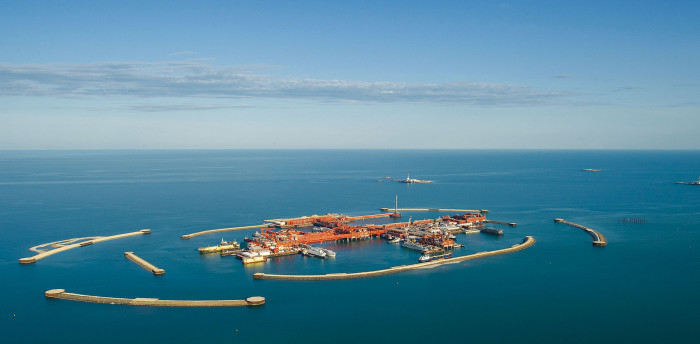 On April 16, Kazakhstan's Oil and Gas Minister Sauat Mynbayev made a statement that drew much attention from both domestic and international media and should certainly have been widely commented on in several capitals, including Washington, Moscow, Beijing and New Delhi. After walking out of a regular government meeting, Mynbayev officially confirmed China interest in the Kashagan's oil project. This vast and complex undertaking in the Kazakhstani sector of the Caspian Sea has already cost its investors over $116 billion by August 2012, ahead of the Gorgon and Ichthys gas projects in Australia worth $57 billion and $43 billion, respectively (Newskaz.ru, April 16; The Astana Times, January 11; CNN Money, August 27, 2012)
On April 16, Kazakhstan's Oil and Gas Minister Sauat Mynbayev made a statement that drew much attention from both domestic and international media and should certainly have been widely commented on in several capitals, including Washington, Moscow, Beijing and New Delhi. After walking out of a regular government meeting, Mynbayev officially confirmed China interest in the Kashagan's oil project. This vast and complex undertaking in the Kazakhstani sector of the Caspian Sea has already cost its investors over $116 billion by August 2012, ahead of the Gorgon and Ichthys gas projects in Australia worth $57 billion and $43 billion, respectively (Newskaz.ru, April 16; The Astana Times, January 11; CNN Money, August 27, 2012)
Last October, the United States major oil company ConocoPhillips decided to withdraw from Kashagan. The North Caspian Operating Company (NCOC), which represents an international consortium responsible for the launch of production at Kashagan, also has on its board such energy giants as ExxonMobil, Total, Eni, Royal Dutch Shell and KazMunaiGas, Kazakhstan’s oil and gas operator, as well as ConocoPhillips and Inpex. Whereas the former five companies own 16.81 percent each, Conoco’s and Inpex’s stakes are only 8.4 and 7.56 percent, respectively. Conoco’s exit strategy in the case of Kashagan has been in full compliance with its global policy of cutting back on relatively unprofitable overseas assets as part of its return to the US domestic market to focus on promising shale gas projects (see EDM, December 5, 2012).
As the news of Conoco’s forthcoming departure from Kazakhstan spread across the media, India’s Oil and Natural Gas Corporation (ONGC) announced its intention to acquire the US company’s stake in Kashagan for $5 billion. This decision was widely hailed in India not only as ONGC’s biggest acquisition in recent years but also as a unique opportunity for New Delhi to expand its presence in the Caspian region. Unlike other great powers with far-reaching regional aspirations, India has been massively absent from Kazakhstan’s oil and gas industry. In April 2011, during Prime Minister Manmohan Singh’s visit to Astana, New Delhi finally succeeded in concluding its first major oil contract by purchasing a 25-percent stake in the Satpayev offshore block for $400 million. While the Indian press cheerfully commented on this commercial success, it should not be forgotten that it came as a result of tense and protracted negotiations that had required several high-level visits and rounds of bilateral talks (Tengrinews.kz, April 16, 2011).
According to Kashagan’s production-sharing agreement concluded between the Kazakhstani government and foreign investors back in 1997, Kazakhstan wields veto power, allowing it to purchase any stakes on sale in the project ahead of other partners or to block prospective purchases due to the strategic nature of the deposit. Despite ONGC’s success in securing the approval of all the foreign investors already present at Kashagan, Kazakhstani authorities initially decided to postpone their final verdict until the end of May when a six-month consideration period was set to expire. While the eventuality of direct talks between China Petroleum National Corporation (CNPC) and ConocoPhillips was discarded on multiple occasions, Kazakhstan has not offered any reassuring signals to its Indian partner. During his March 2013 visit to New Delhi, Kazakhstani Foreign Minister Erlan Idrissov refused to share any thoughts on the outcome of government deliberations, stressing instead the importance of Kazakhstani-Indian cooperation in other fields (I-news.kz, March 4).
Since Kazakhstan has already pledged considerable funding to several ongoing large-scale investment projects, such as the modernization of its three oil refineries and the construction of the local segment of the Western Europe–Western China highway, it is unlikely to have sufficient funds to acquire Conoco’s stake. However, it still may decide to proceed with the deal, expecting to resell this share to CNPC or counting on the establishment of a joint venture between CNPC and KazMunaiGas that would provide the former with de facto access to Kashagan’s immense hydrocarbon reserves. China has been traditionally cautious in manifesting its energy appetites in neighboring Kazakhstan and has preferred to invest in joint ventures rather than apply for direct participation via its oil and gas companies. While CNPC-AktobeMunaiGas is one example of China’s energy diplomacy, there are myriads of small- and medium-sized service companies dominated by Chinese capital in Kazakhstan’s western provinces.
China’s presence in the Kazakhstani oil and gas sector has considerably expanded during the last decade. On his recent visit to Beijing, Kazakhstan’s President Nursultan Nazarbayev declared that China accounts for some 25 percent of oil production in his country, which is a modest achievement if compared to the relevant figures reflecting the influence of energy giants from the US, Europe and Russia. However, unidentified sources cited by the Kazakhstani media in early January speculated that China’s share might be as high as 40 percent and could only grow, leading to the progressive marginalization of both foreign oil and gas players and Kazakhstan itself. China’s energy relations with Kazakhstan have recently further strengthened after the head of KazTransOil unveiled plans for the increase of oil flows from the Caspian to the Chinese westernmost province of Xinjiang. According to the latest statistics, the transit of oil via the Atasu-Alashankou pipeline grew by 36 percent in January–March 2013 on a year-on-year basis (Zonakz.net, April 19; Thenews.kz, April 6; Ktk.kz, January 8).
Beijing’s success at Kashagan comes not only at the expense of India, which has been China’s long-time rival and continues to view Chinese influence as a threat to its geopolitical positions, but also Russia. Despite the fears nurtured by Moscow’s intention to promote political and economic integration within the Eurasian Union, China’s rapidly expanding economic presence in Kazakhstan and more broadly in Central Asia represents a far more serious challenge. Unlike Russia playing the regional integration card, China has preferred to focus on bilateral partnerships, quietly promoting its interests in such areas as Kyrgyzstan’s mining sector or Uzbekistan’s and Turkmenistan’s gas production. It is also barely enthusiastic about providing security guarantees to Central Asian neighbors despite their collective membership in the Shanghai Cooperation Organization. While Moscow has recently been struggling to secure Dushanbe’s long-term agreement to the preservation of its military base close to the border between Tajikistan and Afghanistan, China is actively engaged in the consolidation of its trade relations with the Central Asian republics. Therefore, there should be no confusion as to who, Russia or China, is the real vector of influence in the region.
Georgiy Voloshin, Eurasia Daily Monitor




